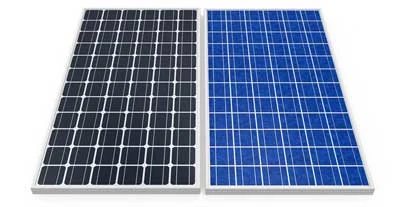by Malcolm Woods
Did you know that going solar for a year would be like avoiding to burn about eight thousand pounds of coal?
Thankfully, the sun produces enough energy to power up your home, and again, the price of solar has reduced by over 70 percent over the last decade.
So, if you're planning to install solar panels on your roof, you are on the right track. You'll not only reduce your power bills but also save our environment by going green.
Contents
Now, if you've tried checking out the options for solar panels online or at the physical stores, you might have noted they are endless. There are all sorts of brands and models out there, each claiming to offer the best quality.
That might leave you a little confused, as they cannot all be right.
I am here to clear the confusion and help you get the model that suits your circumstances. In this guide, we'll be talking about the factors to look at when shopping for the right solar panel.
Let's jump in.


There are two major categories of solar panels in the market right now. These are - monocrystalline, known simply as mono, and polycrystalline, simply called poly.
The working process is quite the same for both. These are made from silicon and draw energy from the sun to convert it into electricity.
The only difference in those is the usage of silicon. While mono panels are made from a single silicon crystal, poly panels are made from multiple silicon crystals that have been melted together.
If efficiency is what you're looking for, then you're better off with mono solar panels. As the silicon in these panels is purer than that in the poly panels, the conversion of light to energy happens more efficiently.
Note: however, that mono panels are more expensive than poly panels. They go for around 300 to 700 dollars per panel.
While mono panels lead to lots of waste during their manufacture, poly panels use all of those. That means poly panels cause less wastage of natural resources. And thus, poly panels might be the better option for someone looking to go green.
Also, poly panels happen to be cheaper than mono panels, going for around 200 to 500 dollars.
On the negatives, poly panels are less efficient. Again, they don't do well in hot climates. If your area's temperatures are often above 80 degrees Fahrenheit, go for the mono panels instead of poly.
Related Resource: https://www.energysage.com/solar/101/monocrystalline-vs-polycrystalline-solar-panels/

For a long time, the standard mono and poly crystalline panels were the only options. But thanks to innovation, there's a new kid in town - thin-film panels. This is made of lightweight materials such as dye-sensitized solar cells.
These are still less efficient than the traditional crystalline panels, but they have a major upside - cost efficiency. If you're on a budget, you will find them quite attractive.
Also, the thin-film panels are more flexible and easier to handle than the standard crystalline ones, which happen to be fairly rigid and a bit fragile.
Before getting a thin-film model, keep this in mind: thin-film panels demand more space for installation, so if you have a small roof, they might be impractical.
As a matter of fact, you might need up to twice the space you'd need for a standard crystalline model with the same output level.
Read more: How Does Indoor Solar Lights Work
The inverter is an important part of a solar panel. An inverter is a device that converts the stored solar energy from DC (direct current) to the AC (alternating current), which the electrical appliance can use.
Recommendation - Pick Central Inverters for Reliability
Central inverters have been around the longest and they're also the most common. Until today, these inverters are the most reliable due to their ability to work in any weather condition.
However, these inverters are relatively expensive. going for 1500 to 2500 dollars.
Recommendation - Choose String Inverters for Cost Efficiency
String inverters are a subsect of central inverters. They are less efficient than the central inverters. It also costs lower.
Remember, these inverters work with only the flat roofs. If your roof isn't flat, using this inverter might be a terrible idea.
Recommendation - Select Power Optimizers If You're Installing in A Partial Shade
One thing is for certain - solar panels draw energy from direct sunlight. They cannot operate in a place that is always in the shade.
That being said, it is not like you cannot use solar if you live in a place where the sun gets obstructed (by clouds or whatever) often.
If you live in a shady location, power optimizer inverters are there for you. These work by maximizing the conversion of energy from the sun.
But, they're a bit costly, going for upwards of 2000 dollars.
Recommendation - Pick Microinverters for Durability
Most inverters fail to work if even a single panel on the solar fails or breaks. That means you have to replace or repair the whole solar panel.
But you can get rid of this problem by using the microinverter. Microinverter works fine even after a few panels stop working. In this situation, you need to change only those panels, not the whole solar.
If you're looking for something durable and reliable, the microinverter is your ideal choice. Another perk is that when it comes to the ease of installation, microinverters are the best.
On the flip side, it is the most expensive inverter type, going for an upward of 2300 dollars.
You might prefer the appearance of certain panels to others. It's all about your preference.
Generally, many people feel the thin-film panels have a sleeker and more uniform look. While that may be true, these panels also take up a substantial amount of space to make up for the lower efficiency.
Next, we will discuss the available options with regard to mounting positions.
There are 4 options:
As the name suggests, hybrids are the combination of two models - mechanically-attached and ballasted. These feature a secure attachment like that of the mechanically-attached models but the mount is a bit raised and sometimes angled to capture more sunlight.
With this model, the panel is tightly attached to the roof. There's usually a very small angle or none at all. Again, this amount is relatively smaller.
Since this arrangement is super secure, it works well in harsh climates where there are high winds.
The small size of the mount is also suitable for small roofs.
Perhaps your roof is not suitable for solar panel installation. In that case, you might want to consider a ground mount.
If you have some good space in the yard, talk to an accredited installer and see if a ground-mounted installation will work. Be sure to get the relevant permissions from your homeowner's association.
Note: ground-mounted installations usually cost higher than rooftop installations.
The ballasted mount is whereby the panel is attached at a distance of up to a few feet above the roof.
Because of this arrangement, it is crucial that the mount option is used in a place with low/slow winds. You don't want the installation to get blown away, do you?
Also Know: Types of the solar charge controller
In this section, I am going to look at the personal consideration questions you might ask to get the right decision.

If someone getting a solar panel for a commercial or industrial building, a monocrystalline panel is probably the best choice. It offers higher efficiency.
On the contrary, the polycrystalline model might be all right for the residential buildings.
If you're using lots of energy every month, it is likely the bill is usually quite enormous. A monochromatic model may be expensive to install, but in the long run, it will help you save more due to its high efficiency at energy conversion.
But if you don't need much energy, a thin-film model, which doesn't produce much energy but attracts a lower initial cost may be more suitable.
For solar panels, there are two types of warranties. There's the product warranty, which is usually offered by the seller. And then there's the manufacturer's warranty, which the original manufacturer provides.
Remember, the manufacturer's warranty signifies the maker's confidence in the reliability and sturdiness of the product.
A product warranty of 5 to 10 years is fine, but if you're to get something worthy, you want it to have a manufacturer's warranty for at least 25 years.
While I may encourage you to get a high-end model to save more in the long run, the truth is that not everyone is able to make such an investment.
If you have a big budget, go for a monochromatic model and a central inverter. On the other hand, if you have a tight budget, look for a thin-film panel with a string inverter.
Again, if your budget is low, you should avoid ground mounting. Look for a ballasted mount if the winds are not high in your area.
In their effort to try and get the people to go green and conserve the environment, the government offers rebates as an incentive for the installation of solar panels. Perhaps your country has this program. If it does, that would be great as it would reduce the total cost of installation.
Approach an attorney to find out about the government's solar installation incentives in your country. You may end up getting back up to 50 percent of the net amount you spent on the installation.
If you haven't installed solar panels at your home, it might be time to do so. It will not only reduce your electric bills but also saves our planet.
I hope this guide has been helpful in picking the right solar panel for your needs. If you still have doubts, look for a friend who has installed solar panels and ask for help.
If you're still confused about the solar panel installation, feel free to comment below. Our professionals will response to your inquiries ASAP.
 |
 |
 |
 |

About Malcolm Woods
Malcolm Woods is a blogger who enjoys writing about technology and solar power. He has a passion for learning new things, and loves to share his knowledge with others. Malcolm is also an advocate for sustainable living, and believes that everyone has a responsibility to do their part in preserving our planet.
 |
 |
 |
 |
Check These Out
Go for the FREE Gifts. Or check out for free energy books from our best collection.
Remove Ad block to reveal all the secrets. Once done, hit a button below
 |
 |
 |
 |